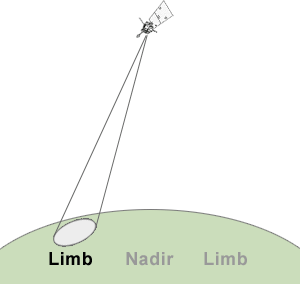|
For remote sensing instruments, the distance between the
sensor and the target plays a large role in the amount and quality
of data produced. Also, due to the factors defined below, the
spatial resolution will vary from image center to the edge of the
swath.
-
Instantaneous Field of View : The angular cone of visibility of a
remote sensor. It determines the area on the Earth's surface sensed
at a particular moment in time.
- Nadir : The point on the Earth's surface
directly below the satellite. Spatial Resolution is optimal here.
Also called the sub-satellite point.
- Limb : The edge of the apparent disk of a
celestial body. Also used to refer to either edge of the sensor's
swath, as shown in the graphic at right. Since the sensor IFOV is
distorted at the limb, spatial resolution will be lower here.
|
 |

